Improvements in hardness and durability have yet to approach a limit. Even roller-cone bits are being improved with new metallurgy.
Perry Fischer, Editor
Some time ago, a lease operator told me that drilling penetration rates had gotten so fast that the move and setup time between wells was beginning to dominate the process. Durability began to soar in parallel, causing drilling contractors to wonder just how many rigs could be eliminated while still maintaining the same wells-drilled count. Unfortunately for drilling contractors, there is no sign yet that ROP and mean time between failures (that is, tripping out to replace a bit) are approaching any sort of limit. This year’s advances include the expected bit design improvements, but also some new metallurgy for cutters and for roller-cone toothed bits.
NOV
High-content tungsten-carbide tooth. NOV recently introduced its proprietary new cutter—the Downhole ReedHycalog TuffCutter Forged-In tooth. New hard metal provides the highest percentage of tungsten carbide of any tooth-bit hard metal, Fig. 1.
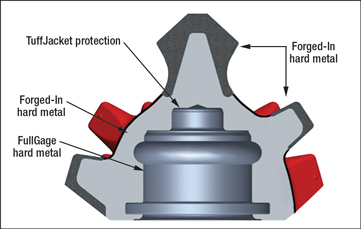 |
|
Fig. 1. Design and hard metal distribution of NOV’s Downhole ReedHycalog TuffCutter Forged-In tooth.
|
|
Conventional tooth bits require welding to apply tungsten carbide hard surfacing to the cone teeth. Tungsten carbide begins to melt at 2,160°F. Welding temperatures are around 3,000°F, which damages the surface tunsgsten carbide pellets, resulting in less tungsten carbide at the surface and more at the base of the weld material. The maximum overall percentage of effective tungsten carbide volume is around 40%.
Proprietary Forged-In hard metal has a higher percentage of tungsten carbide than can be had with conventional welding methods. The Powder Forge process limits temperature to 2,100°F, thereby eliminating the tendency to melt the tungsten carbide pellets. The resultant hard metal is a homogenous mix of tungsten carbide pellets throughout the application thickness with a volume percentage in the 60% range.
Combining this hard metal and two other proprietary hard metals—namely, FullGage, on the face of the tooth, and TuffJacket, which protects the exterior of the cone—results in the latest generation of the company’s TuffCutter bits.
Performance example. These bits are setting ROP records with excellent dull conditions in highly abrasive applications such as the Pinedale Anticline in Sublette County, Wyoming. There, roller cone runs in the Mesa section using a 12¼-in. TC11 bit averaged 2,495 ft over 13 hr and 12 runs, with an average ROP of 197 ft/hr. A competitor’s bit averaged 2,484 ft over 16.7 hr and 47 runs, with an average ROP of 163 ft/hr. The dull grade averaged 64% less on the inner rows and 57% less on the outer rows compared to the other bit.
As for PDC cutters, the company introduced its new DuraForce impact-resistant cutters. They are the latest generation of the company’s well-known Raptor Deep-Leached Thermostable PDC cutters, and have significantly enhanced toughness. The greatest challenge to improving impact resistance is to substantially reduce or eliminate the risk of catastrophic diamond-table loss. This occurs when internal residual stresses within the cutter lead to the loss of large pieces of polycrystalline diamond as a result of cutter overload or impact.
In addition to the obvious reduction in bit durability, a single catastrophic diamond-table loss can adversely affect the stability of a carefully crafted cutting structure. The cutter platform, post-processing operations, interface geometry and materials (both diamond and carbide) all affect internal residual stresses.
DuraForce cutters are designed to significantly reduce the residual stresses between diamond and carbide. By re-engineering the materials and geometry, these cutters reduce the risk of catastrophic diamond-table loss, thereby reliably and repeatedly improving bit performance. Fig. 2. This can be demonstrated in the field in terms of consistent increases in durability and penetration rate with reduced drilling costs.
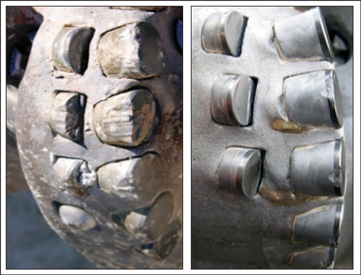 |
|
Fig. 2. Performance dullness comparison of a competitor bit with direct offset cutters and the NOV Downhole DuraForce bit (right), after drilling in Shelby County, Texas. The new bit shows no catastrophic diamond table loss.
|
|
Further performance examples. Setting a double record, a 97⁄8-in. DSF616 (six blades, 16-mm DuraForce cutters), run on an NOV motor, drilled the longest interval at the highest ROP in Bossier Parish, Louisiana. The bit went in at 1,855 ft, drilling vertically for a total of 6,412 ft, at an outstanding ROP of 96.4 ft/hr. When compared to the offset average, the bit achieved a 10.3% increase in the interval drilled, with 77.5% faster ROP and 42.25% lower cost per foot, resulting in a savings of about $66,000.
The objective in the next run was to demonstrate cutter durability while drilling the longest interval in a single run at a competitive ROP. The 8¾-in. DSF713 (seven blades, 13-mm DuraForce cutters) set a record for ROP and interval in De Soto Parish, Louisiana. The bit went in at 8,065 ft and drilled a total of 3,335 ft at an excellent average ROP of 32.1 ft/hr. The bit showed very good durability and was dull graded as 1-2-WT-S-X-I-BT-TD. When compared to the offset average, the DuraForce bit achieved 90% faster ROP, a 312% increase in the interval drilled, and 65.36% lower cost per foot, resulting in savings of about $200,000.
SMITH BITS
New PDC cutters deliver excellent wear and impact resistance and improved thermal stability. Demanding hard and/or abrasive formations and interbedded hole sections composed of sandstone and carbonate rocks have historically been the limiting factors controlling PDC bit application. The high rock strength and varying nature of formations made smooth, stable drilling virtually impossible. Even the toughest PDC bits could not withstand the punishment of the difficult downhole environment without sustaining ROP-killing cutter damage.
The challenging development process began by analyzing the levels of frictional heat generated at the rock/cutter interface. High temperature is the critical factor that makes PDC drilling in hard/abrasive formations difficult. Additionally, since PDC bits are required to drill longer intervals at deeper depths, the mechanisms of thermal degradation and micro-chipping are intensified, further reducing PDC cutter life.
Engineers studied the three key functional properties that dictate PDC cutter life: thermal stability, wear resistance and impact strength. The analysis revealed that different applications require different cutter properties. Generally, wear resistance and thermal stability are required for drilling sandstone, siltstone and other abrasive formations, while a more impact-resistant cutter is best suited for drilling interbedded sections and formations with higher rock strength.
These gains in application knowledge resulted in an R&D effort that focused on raw PDC material selection and processing. Manufacturing engineers created an HPHT manufacturing method and a unique finishing procedure that ensures superior cutter quality and performance. Combined, these two processes significantly improved the cutter’s thermal properties, giving them greater wear resistance and fatigue life than either standard or premium PDC cutters. The company calls the new cutter technology Onyx. The new cutters are capable of maintaining a sharp, efficient cutting edge in abrasive sands and hard carbonates. The improved endurance translates into greater total footage drilled at maximum penetration rates. Field trials have established new performance benchmarks in the world’s toughest drilling applications, including fields in West Africa, East Texas and the North Sea.
Performance examples. Drilling a challenging 12¼-in. hole section in West Africa with PDC bits was producing unacceptable results. The deepwater operation was expensive, with a rig rate of over $1 million a day. The section consisted of hard/abrasive interbedded sand and shale with compressive strengths in excess of 20,000 psi. Typically, the 12¼-in. section required four to eight bits per run to complete. In most cases, PDCs were pulled in poor dull condition suffering from ring-out and worn cutters. The initial goal was to drill the 12¼-in. section in one run or eliminate as many trips as possible.
To accomplish the objective, engineers needed to design a bit body that would remain dynamically stable to minimize adverse cutter loading and remain vibration-free during drilling. The result was the eight-bladed 12¼-in. MDSi816 bit fitted with back-up cutters and optimized blade and nozzle geometry for enhanced cleaning and maximum hydraulic efficiency, Fig. 3.
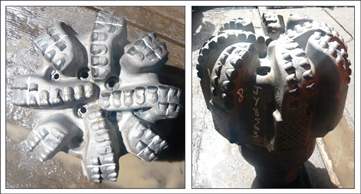 |
|
Fig. 3. The cost-cutting, record-setting 12¼-in. MDSi816 with new Onyx cutter technology.
|
|
The bit was run in a highly abrasive formation on a rotary steerable BHA on Well 2 and Well 5 with great results. On Well 2, the bit drilled the entire 12¼-in. hole section from shoe to TD for the first time in field history and in the region. The reduction in trip time saved the operator six days of NPT, reducing costs by $2 million.
On Well 5, the total footage and ROP performance of the bit was much higher. Compared to the three-well offset average (six bit runs), the new PDC bit drilled 165% further (1,702 m) with an ROP of 21.18 m/hr—an increase of 122%—in addition to completing the hole section in one run, Table 1. As an added benefit, the bit was pulled green with a dull grade of 1-2-WT-A-XXX-IN-DL-TD.
| TABLE 1. Run details on four offset wells |
 |
VAREL INTERNATIONAL
New PDC bit proven successful. The Diamond Edge (Fig. 4) is a proprietary PDC drillbit designed to run at high penetration rates even in applications that call for higher blade and cutter counts. Its unique cutting structure layout adds another dimension to bit stability and smooth running by combining the penetration rate potential of traditional “single set” cutter layouts with the life-extending features of a “plural set” cutter layout. The result is a bit that runs up to 20% faster than conventional PDC bits with minimum bit wear.
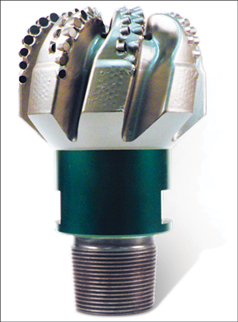 |
|
Fig. 4. Varel International’s new Diamond Edge bit.
|
|
The new bit extends the advantages of an asymmetric blade-cutting structure in the control of bit vibration by adding precisely defined plural cutter-blade asymmetry. This proprietary approach enhances both stability and ROP. You get more out of the bit, and more out of the diamond on the bit.
These bits work across an extended range of weight on bit, penetrating quickly even at low bit weights in softer rock. When formations firm up, the bits can take added weight with a smooth torque response and maintain higher than competitive rates of penetration.
The technology is a departure from traditional plural-set bits, which require higher weights to drill even in soft rock, and are generally durable but slow in harder rock. Traditional plural-set bits also can produce an erratic torque response when taking additional weight.
The new bit provides a unique cutting structure specially equipped for transitional zones and hard rock drilling. This innovative design allows operators to recognize drilling efficiencies through increased ROP, enhanced stability and optimum durability.
Performance examples. A major operator in Hill County, Texas, needed a bit that could withstand formations known to be extremely hard and abrasive. He used an 8¾-in. DE713PUX Diamond Edge bit in place of a roller cone bit, which had historically been used. Plans in the area called for a kick-off deep downhole, requiring a bit that was steerable and durable enough to maintain steerability after enduring abrasive sands. Formation tops occur at 5,820−7,910 ft (Bend Conglomerate), 7,910−8,100 ft (Marble Falls) and 8,100−8,220 ft (Barnett).
The DE713PUX drilled down to 8,120 ft in 30.5 hr while improving ROP to 45.2 ft/hr. The bit drilled twice as fast as a traditional bit in the section, drilling a typical two-bit interval in just one run. Cost per foot was $46.72, or 42% less than the next lowest-cost-per-foot bit (an FH123B bit).
In another Texas well, this one in Upton County, a 7 7⁄8-in. DE716X Diamond Edge bit was employed to drill 5,815 ft to reach a 10,635-ft TD. The run had the lowest average weight on bit (at least 10% less) compared to other runs in the area. The driller reached TD in 120.5 hr, which was a 7% improvement.
HUGHES CHRISTENSEN
New PDC bit improves stability and lowers costs in demanding drilling environments. Baker Hughes unveiled a new line of Hughes Christensen PDC bits (Fig. 5) featuring newly engineered stabilization and next-generation cutters to deliver improved performance in the Barnett Shale, Travis Peak and similar drilling environments.
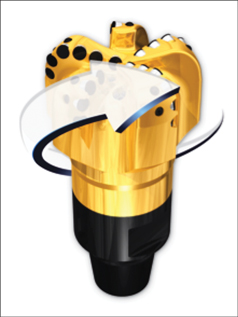 |
|
Fig. 5. The new Hughes Christensen PDC bits incorporate the latest generation of stabilization and cutter technologies.
|
|
The primary focus of the new design centers on improving dynamic stability and performance in a range of difficult applications. When drilling in hard rock, or through the hard stringers of interbedded formations, penetration rates drop, leading to a low Depth Of Cut (DOC). With conventional PDC bits, DOC frequently results in highly destructive whirl. When bit whirl occurs, the cutters are not uniformly engaging the formation, which leads to very inefficient drilling, dramatically lower ROP and, often, premature cutting-structure breakdown, resulting in short bit runs that increase overall drilling costs.
For this latest bit advancement, the design teams employed a proprietary bit dynamics model that optimized the force distribution to enhance stability and deliver penetration rates in many cases 40% faster than offsets. With the new design methodology, the entire cutting structure is loaded more consistently, thereby optimizing efficiency and stability at progressively higher penetration rates. This increase in energy efficiency allows the newer bits to drill more quickly in soft and hard formations alike.
Next-generation cutters. Along with the optimized design practices, the new PDC line incorporates the latest generation of cutters, which are substantially more wear-resistant than previous designs. Created with the diamond manufacturing technology, the new cutters feature an optimized carbide substrate interface that is critical for balancing cutter stress. By employing Finite Element Analysis (FEA), the diamond research team developed a design that significantly reduces residual stresses, while relocating primary stresses away from the vulnerable cutting edge.
Depending on the demands of the drilling application, the new bit line features choices in cutter technology to address the challenges associated with a particular application. One cutter type is geared specifically for abrasive formations, while another is engineered more to meet the needs of drilling environments where both abrasion and impact resistance are required.
Performance improvement examples. In a variety of applications, the new bit product line is consistently exhibiting much-improved durability and penetration rates compared with other PDC bits in comparable downhole environments.
In a Barnett Shale application in North Texas, an 8¾-in. version of the new design drilled 1,873 ft in intervals of Atoka sand and Bend conglomerate at an average of 47 ft/hr, while holding tangent to the kickoff point. This interval has historically been drilled with roller cone bits, but the new PDC bit drilled the entire interval at a much more cost-effective penetration rate. This run saved the operator nearly 35 hr of drill time, for savings of more than $58,000.
In Colorado’s Piceance Basin, two of the new designs successfully drilled the lower 7 7⁄8-in. section through more than 3,000 ft of interbedded sandstone and shale to reach total depth. These runs drilled 37% more footage at a penetration rate that was 22% higher than the average offset. The two runs combined to save the operator 34 hr of drilling time and $49,000 in drilling costs.
In a Travis Peak/Cotton Valley transition run in Limestone County, Texas, a 7 7⁄8-in. new-generation PDC bit drilled an unsurpassed 1,269 ft through ratty hard sandstone and soft shale sequences. With an ROP of 21.3 ft/hr, the bit run was 31% faster than the offset well average and, more remarkably, the bit drilled 122% more footage than the average comparable wells within a 6-mi radius. The run reduced the operator’s drilling cost by $24/ft. 
Editor’s note: World Oil is not responsible for performance claims made by the manufacturers and vendors herein.
|








